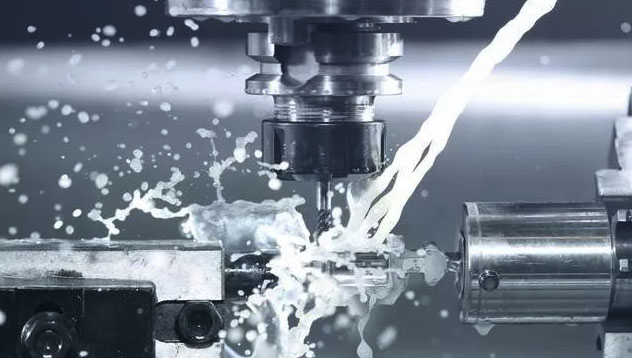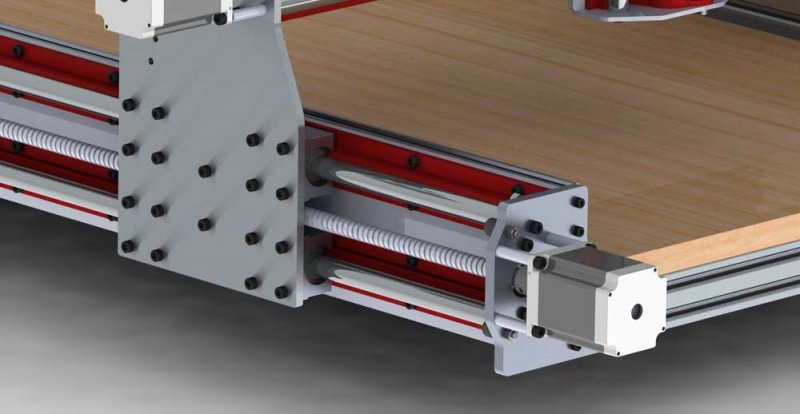Precision, effectiveness, and durability are of the utmost importance when it comes to CNC machines. It is important to accomplish these attributes that guide the machine's movements: the hard rail and the linear rail systems. These two types play a crucial role in ensuring a smooth and precise operation of CNC machines, which impacts everything from the finished product's quality to the machine's lifespan.
This article will explain the hard rails and linear rails, exploring their design, construction, functionality, and performance. We will also discuss these two rail types to provide a comprehensive understanding of their roles in CNC machines. Moreover, we will help to make informed decisions about the best rail system for specific needs. Let’s get started!

A type of linear guide system that is frequently utilized in CNC machines is hard rails, also referred to as box ways or square rails. The robustness and capacity of these rails to support heavy loads make them unique. Hard rails typically involve a direct sliding contact between the rail and the moving component, in contrast to linear rails, which employ rolling elements. This direct contact can deal with significant forces and impact, making hard rails ideal for heavy-duty machining activities.

The need for long-lasting and reliable guide systems in industrial machinery gave rise to the concept of hard rails, which has been around for decades. Early CNC machines and their predecessors relied on rudimentary sliding mechanisms that evolved into today's hard rail systems before the advent of modern materials and precision engineering. Hard rails' place in high-load and high-impact applications has been established thanks to advancements in metallurgy, manufacturing methods, and surface treatments over time. These advancements have also increased their performance and reliability.
Hard rails are built from solidified steel, a material known for its extraordinary strength and wear resistance. The rails will be able to withstand the rigors of heavy machining tasks because they have been subjected to a heat treatment process that increases the hardness of hardened steel. At times, extra surface treatments like nitriding or coating with a wear-resistance layer are applied to additional upgrade the strength and life expectancy of the hard rails.
In order to ensure precision and durability, the manufacturing process of hard rails involves a number of crucial steps. The underlying phase incorporates cutting the steel to the required dimensions, followed by a series of heat treatments to accomplish the ideal hardness. Grinding and polishing processes are then utilized to achieve a smooth and accurate surface finish. This accurate finishing is critical, as any irregularities can lead to friction and wear. Finally, quality control measures like hardness testing and dimensional inspections are carried out to ensure that the rails meet strict industry standards.
One of the hard rails' most distinctive characteristics is their impressive load-bearing capacity. Due to the direct sliding contact, hard rails can support substantial weights without deforming or losing accuracy. Because of this, they are ideal for applications that require heavy machining forces and large workpieces.
The precision and accuracy of hard rails can vary depending on the manufacturing process's quality despite their superior load-bearing capabilities. For many machining tasks, high-quality hard rails offer high levels of precision. However, they might not be as precise as some linear rail systems, especially in applications that require very tight tolerances.
Moreover, hard rails are known for their durability. The solidified steel construction and potential surface treatments give excellent wear resistance, permitting these rails to maintain their performance over extended periods of heavy use. Regular maintenance, such as lubrication, can additionally improve their life span.
Follow the below advantages of hard rails:
• Robustness
Due to their solid construction and design, hard rails are durable. This robustness can endure critical mechanical stresses and impacts, making them appropriate for heavy-duty applications.
• Cost-Effectiveness
Hard rails are more cost-effective than their linear rail counterparts. Because they don't have any complicated rolling parts and are simple to build, they cost less to manufacture and maintain, making them a good choice for businesses with tight budgets.
• High Load Capacity
A significant advantage of hard rails is their high load capacity. Hard rails provide the necessary support and stability in applications where heavy loads are common, such as large-scale milling or turning operations.
Here are the disadvantages of hard rails:
• Higher Friction
The higher friction that is inherent in the design of hard rails is a significant disadvantage. The direct sliding contact between the rail and the moving part produces more grinding contrasted with rolling element systems. Over time, increased wear and increased energy consumption may result from this increased friction.
• Maintenance Requirements
Hard rails need to be maintained regularly because of their potential for wear and higher friction. Lubrication is necessary to reduce wear and friction, and periodic inspections are required to keep the rails in good condition. This maintenance can be more intensive than that of linear rail systems.
• Limited Speed Capabilities
Hard rails have direct contact and higher friction, which also limits speed capabilities. While they are fantastic for heavy loads and high-influence applications, hard rails are not ideal for high-speed operations. The increased resistance can cause overheating and extreme wear at high paces, making them less appropriate for applications requiring rapid movements.
Linear rails, also known as linear guideways or linear motion guides, are a type of bearing system that allows CNC machines to move in a smooth and precise linear direction. They consist of a carriage and a rail that houses rolling components, like balls or rollers, that move along the rail. This design reduces friction and considers high-precision movement, making linear rails ideal for applications requiring high accuracy and repeatability.

The advancement of linear rails can be followed back to the mid-twentieth century, driven by the requirement for more precise and productive linear motion systems in different modern applications. Early designs used a simple sliding mechanism; however, progressions in materials and design prompted the inclusion of rolling components, essentially decreasing friction and wear. The development of linear rail technology has improved CNC machining with continuous enhancements in accuracy, load capacity, and durability.
Linear rails are constructed from high-quality materials like stainless steel and aluminum. Stainless steel is frequently utilized for its corrosion resistance, strength, and solidness. However, aluminum is selected for applications where weight reduction is significant, giving a good balance between strength and lightness. Hardened steel or ceramics are typically used to make the rolling parts of the carriage, like the balls or rollers, which are extremely durable and resistant to wear.
The manufacturing process of linear rails includes several stages to guarantee high accuracy and quality. The rails are typically created through processes like extrusion (for aluminum) or accuracy grinding (for steel). These processes ensure the rails have a smooth and accurate surface finish. Carriages are made with high precision, incorporating rolling components that are carefully chosen and tested for consistency and performance. After assembling, the entire system goes through testing and quality control checks to guarantee it meets the required specifications for accuracy and sturdiness.
Linear rails provide a good balance of precision and load-bearing capacity. They are designed to distribute loads equitably across the moving components, which assists in keeping up with smoothing movement and decreasing wear. Although linear rails aren't as strong as hard rails when it comes to handling extremely high loads, they are strong enough for most precision machining applications.
One of the linear rails' primary benefits is the high level of precision and accuracy offered. For applications requiring tight tolerances, the rolling element's design allows for extremely smooth motion and minimizes friction. Due to their high level of precision, linear rails are suitable for tasks that require repeatable accuracy, such as manufacturing semiconductors and medical devices.
Furthermore, linear rails are designed to perform for a long time with minimal wear. The rolling element's design and the materials used provide excellent wear resistance. However, they do need to be lubricated and maintained regularly to keep their performance at their best and to avoid contamination that could disrupt their operation.
Let’s discuss the advantages of linear rails:
• Low Friction and Smooth Motion
When compared to hard rails, linear rails' rolling elements significantly reduce friction. For high-precision applications, this low friction allows for easy and smooth movement. Additionally, the smooth motion results in reduced component wear and lower energy consumption.
• High Accuracy and Precision
Linear rails are designed to be extremely accurate and precise. CNC machines can achieve the tight tolerances required in many advanced manufacturing processes because the rolling elements enable consistent and smooth movement. This accuracy is especially advantageous in industries like aerospace, electronics, and medical devices.
• Appropriate for High-Speed Applications
The low friction and efficient design of linear rails make them ideal for high-speed applications. They can maintain accuracy and performance even at high speeds, making them appropriate for tasks that require rapid movement and quick adjustments.
Here are the drawbacks of linear rails:
• Higher Cost
One of the fundamental drawbacks of linear rails is their higher cost as compared to hard rails. Linear rails are more expensive because of the materials, manufacturing processes, and precision engineering involved in their production. However, this cost can be justified by the performance advantages they provide in high-precision applications.
• Possibility of Contamination and the Need for Cleanliness
Compared to hard rails, linear rails are more susceptible to contamination. Dust, debris, and different contaminants can interfere with the moving components, causing increased friction and wear. Consequently, keeping a clean environment and regular maintenance are basic to guarantee the ideal performance of linear rails.
• Less Robust in Some Applications
Although linear rails offer excellent precision and smooth motion, they may not be as durable as hard rails when it comes to handling extremely high loads or impact forces. Hard rails may be preferable in situations where robustness and the capacity to withstand heavy loads and impacts are essential.
While choosing hard rails and linear rails, manufacturers and CNC machine operators should consider several factors. For applications that include heavy loads and high-impact powers, hard rails are often the better decision because of their strength and cost-effectiveness in such situations. On the other hand, for operations that request high accuracy, low friction, and quick movement, linear rails are the preferred option regardless of their higher cost and maintenance needs. Due to the more stringent cleanliness requirements of linear rails, it is essential to take into account the particular operational environment.
As technology continues to advance, the future of rail systems in CNC machines is ready for significant advancements. One significant trend is the integration of smart technology and IoT (Internet of Things) capabilities. Smart sensors embedded in rails can monitor the system's health and performance in real-time, providing valuable information about wear, lubrication levels, and overall condition. This proactive methodology empowers predictive maintenance, diminishing downtime and extending the lifespan of the rails.

One more promising trend is the enhanced adoption of additive manufacturing strategies in the development of rail systems. Additive manufacturing, or 3D printing, considers the production of complex geometries and custom designs that are impractical with traditional manufacturing techniques. This can prompt the development of rails with optimized shapes for particular applications, further improving performance and reducing weight.
In short, the choice of rail systems plays a significant part in deciding the performance and efficiency of machines. Hard rails and linear rails both have advantages and are tailored to specific operational requirements. We have explained the comparison between hard rail and linear rail in detail, which is fundamental for manufacturers and CNC machine operators to make informed decisions that align with their production goals and requirements.